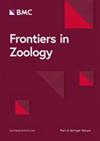CRISPR-Cas9诱导非模式昆虫基因组编辑的可转移方法:简要指南
IF 2.6
2区 生物学
Q1 ZOOLOGY
引用次数: 0
摘要
尽管昆虫种类繁多,形态、发育和生理特征各异,但基因功能的问题长期以来只能在少数模式物种中得到解决。细菌CRISPR-Cas系统适用于真核细胞的基因组编辑,扩大了功能遗传学领域的范围:第一次在非常广泛的生物体中创造可遗传的遗传变化成为可能。从那时起,使用CRISPR-Cas技术的靶向基因组编辑大大增加了在分子遗传工具很少建立的非模式昆虫中进行遗传操作的可能性。该技术允许位点特异性诱变和种系转化。重要的是,它可以用于基因敲除的产生,转基因的敲入和基因报告融合的产生。因此,CRISPR-Cas诱导的基因组编辑可以应用于解决各种昆虫物种和其他研究生物的基础研究中的问题。值得注意的是,它还可以用于应用昆虫生物技术,设计新的害虫和媒介控制策略,如基因驱动和精确引导昆虫不育技术。然而,在一个新的模型中建立CRISPR需要一些实际的考虑,这些考虑取决于科学问题和各自研究生物体的特征。因此,本综述旨在对已经在不同昆虫中建立的基于CRISPR-Cas9的不同方法进行文献综述。在讨论了研究生物所需的一些先决条件后,我们通过实验考虑提供了计划进行CRISPR-Cas9基因组编辑时的指导,例如引导rna的设计和递送,以及Cas9内切酶的设计和递送。我们讨论了使用不同的修复机制,包括同源定向修复(HDR)为一个确定的插入遗传元件。此外,我们描述了不同的分子方法的遗传筛选和使用的可见标记。我们的综述主要集中在昆虫的实验工作上,但由于CRISPR-Cas系统的普遍功能,许多考虑因素可转移到其他非模式生物。本文章由计算机程序翻译,如有差异,请以英文原文为准。
Transferable approaches to CRISPR-Cas9 induced genome editing in non-model insects: a brief guide
Despite the large variety of insect species with divergent morphological, developmental and physiological features questions on gene function could for a long time only be addressed in few model species. The adaption of the bacterial CRISPR-Cas system for genome editing in eukaryotic cells widened the scope of the field of functional genetics: for the first time the creation of heritable genetic changes had become possible in a very broad range of organisms. Since then, targeted genome editing using the CRISPR-Cas technology has greatly increased the possibilities for genetic manipulation in non-model insects where molecular genetic tools were little established. The technology allows for site-specific mutagenesis and germline transformation. Importantly, it can be used for the generation of gene knock-outs, and for the knock-in of transgenes and generation of gene-reporter fusions. CRISPR-Cas induced genome editing can thus be applied to address questions in basic research in various insect species and other study organisms. Notably, it can also be used in applied insect biotechnology to design new pest and vector control strategies such as gene drives and precision guided Sterile Insect Technique. However, establishing CRISPR in a new model requires several practical considerations that depend on the scientific questions and on the characteristics of the respective study organism. Therefore, this review is intended to give a literature overview on different CRISPR-Cas9 based methods that have already been established in diverse insects. After discussing some required pre-conditions of the study organism, we provide a guide through experimental considerations when planning to conduct CRISPR-Cas9 genome editing, such as the design and delivery of guide RNAs, and of Cas9 endonuclease. We discuss the use of different repair mechanisms including homology directed repair (HDR) for a defined insertion of genetic elements. Furthermore, we describe different molecular methods for genetic screening and the use of visible markers. We focus our review on experimental work in insects, but due to the ubiquitous functionality of the CRISPR-Cas system many considerations are transferable to other non-model organisms.
求助全文
通过发布文献求助,成功后即可免费获取论文全文。
去求助
来源期刊

Frontiers in Zoology
ZOOLOGY-
CiteScore
4.90
自引率
0.00%
发文量
29
审稿时长
>12 weeks
期刊介绍:
Frontiers in Zoology is an open access, peer-reviewed online journal publishing high quality research articles and reviews on all aspects of animal life.
As a biological discipline, zoology has one of the longest histories. Today it occasionally appears as though, due to the rapid expansion of life sciences, zoology has been replaced by more or less independent sub-disciplines amongst which exchange is often sparse. However, the recent advance of molecular methodology into "classical" fields of biology, and the development of theories that can explain phenomena on different levels of organisation, has led to a re-integration of zoological disciplines promoting a broader than usual approach to zoological questions. Zoology has re-emerged as an integrative discipline encompassing the most diverse aspects of animal life, from the level of the gene to the level of the ecosystem.
Frontiers in Zoology is the first open access journal focusing on zoology as a whole. It aims to represent and re-unite the various disciplines that look at animal life from different perspectives and at providing the basis for a comprehensive understanding of zoological phenomena on all levels of analysis. Frontiers in Zoology provides a unique opportunity to publish high quality research and reviews on zoological issues that will be internationally accessible to any reader at no cost.
The journal was initiated and is supported by the Deutsche Zoologische Gesellschaft, one of the largest national zoological societies with more than a century-long tradition in promoting high-level zoological research.
 求助内容:
求助内容: 应助结果提醒方式:
应助结果提醒方式:


